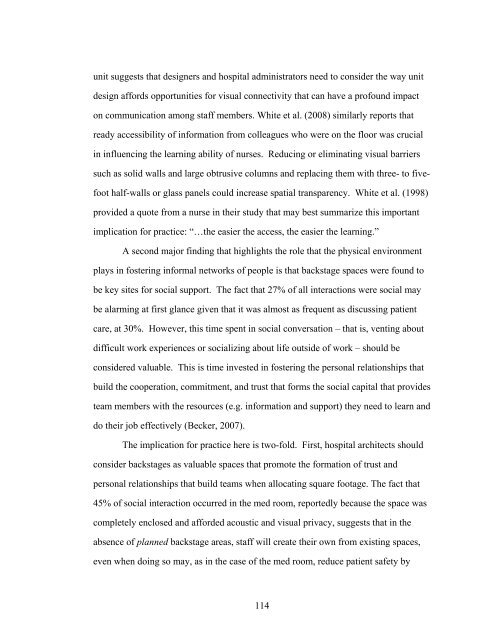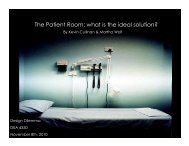The role of physical design and informal communication
The role of physical design and informal communication
The role of physical design and informal communication
Create successful ePaper yourself
Turn your PDF publications into a flip-book with our unique Google optimized e-Paper software.
unit suggests that <strong>design</strong>ers <strong>and</strong> hospital administrators need to consider the way unit<br />
<strong>design</strong> affords opportunities for visual connectivity that can have a pr<strong>of</strong>ound impact<br />
on <strong>communication</strong> among staff members. White et al. (2008) similarly reports that<br />
ready accessibility <strong>of</strong> information from colleagues who were on the floor was crucial<br />
in influencing the learning ability <strong>of</strong> nurses. Reducing or eliminating visual barriers<br />
such as solid walls <strong>and</strong> large obtrusive columns <strong>and</strong> replacing them with three- to five-<br />
foot half-walls or glass panels could increase spatial transparency. White et al. (1998)<br />
provided a quote from a nurse in their study that may best summarize this important<br />
implication for practice: “…the easier the access, the easier the learning.”<br />
A second major finding that highlights the <strong>role</strong> that the <strong>physical</strong> environment<br />
plays in fostering <strong>informal</strong> networks <strong>of</strong> people is that backstage spaces were found to<br />
be key sites for social support. <strong>The</strong> fact that 27% <strong>of</strong> all interactions were social may<br />
be alarming at first glance given that it was almost as frequent as discussing patient<br />
care, at 30%. However, this time spent in social conversation – that is, venting about<br />
difficult work experiences or socializing about life outside <strong>of</strong> work – should be<br />
considered valuable. This is time invested in fostering the personal relationships that<br />
build the cooperation, commitment, <strong>and</strong> trust that forms the social capital that provides<br />
team members with the resources (e.g. information <strong>and</strong> support) they need to learn <strong>and</strong><br />
do their job effectively (Becker, 2007).<br />
<strong>The</strong> implication for practice here is two-fold. First, hospital architects should<br />
consider backstages as valuable spaces that promote the formation <strong>of</strong> trust <strong>and</strong><br />
personal relationships that build teams when allocating square footage. <strong>The</strong> fact that<br />
45% <strong>of</strong> social interaction occurred in the med room, reportedly because the space was<br />
completely enclosed <strong>and</strong> afforded acoustic <strong>and</strong> visual privacy, suggests that in the<br />
absence <strong>of</strong> planned backstage areas, staff will create their own from existing spaces,<br />
even when doing so may, as in the case <strong>of</strong> the med room, reduce patient safety by<br />
114







